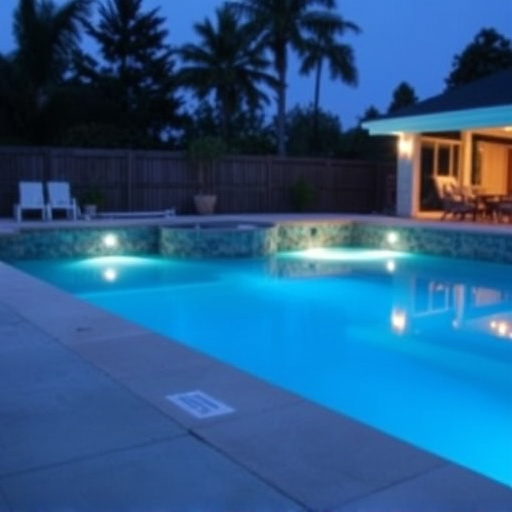Swimming pool alarms for in-ground pools are crucial safety measures, addressing unique risks not faced by above-ground models. These advanced systems use sensors monitoring movement, sound, and water levels to detect accidents involving children or unsuspecting visitors, promptly alerting owners and emergency services. Types include surface displacement sensors and pressure-sensitive mats, with multi-sensor systems offering enhanced accuracy. Installation involves strategic sensor placement, proper wiring, testing, and integration with home security systems. Alarms provide peace of mind, deterring unauthorized access and protecting both family and property. Choosing a reputable provider ensures reliable performance and maintenance.
Swimming pool alarms are essential safety features, especially for homeowners with inground pools. As many accidents go unnoticed, an alarm system acts as a vigilant guardian, detecting unauthorized entry and potential dangers. This article delves into the critical need for these systems, exploring different types suitable for inground pools and their multifaceted benefits. We’ll guide you through the installation process and highlight key considerations, ensuring your pool is protected while enhancing family safety and property security.
Understanding the Need for Swimming Pool Alarms
Swimming pool alarms have become an indispensable safety measure, especially with the growing popularity of in-ground pools. These sophisticated devices serve as a crucial line of defense against potential hazards, providing peace of mind for pool owners and their families. The need for such alarms is multifaceted, addressing both the risks associated with unsupervised swimming and the inherent dangers of in-ground pools themselves.
In-ground pools, due to their buried nature, present unique challenges compared to above-ground models. They often lack visible entry points, making it easier for accidental falls or unauthorized access to go unnoticed. Swimming pool alarms mitigate these risks by detecting movements and sounds within a specified range, triggering alerts that can reach both the pool owner and local emergency services. This proactive approach ensures swift response times, potentially saving lives and preventing accidents, especially in cases where children or unsuspecting visitors are involved.
Types of Pool Alarm Systems: Inground Pools
Inground pool alarm systems are designed to protect swimmers and prevent accidental falls into the water. These systems typically include a range of sensors and devices that monitor various parameters around the pool, such as movement, sound, and water levels. One common type is the surface displacement sensor, which detects any sudden changes in the water’s surface area, signaling a potential threat. Another variety is the pressure-sensitive mat or pad installed along the poolside, capable of sensing weight or movement and triggering an alarm accordingly.
For added security, some advanced inground pool alarms incorporate multiple sensors, combining the aforementioned technologies to enhance accuracy and reliability. These multi-sensor systems can detect not only someone falling into the pool but also unusual behavior or activity on the pool deck. This comprehensive approach ensures that swimming pools, particularly those buried underground, are equipped with robust safety measures, providing peace of mind for pool owners and enhanced protection for swimmers.
How Swimming Pool Alarms Protect Your Family and Property
Swimming pool alarms are essential safety measures, especially for households with children or pets who love to play by the pool. These advanced systems are designed to protect both your loved ones and your property, providing peace of mind while ensuring a secure environment around the inground pools. When an unauthorized person enters the pool area, these alarms instantly detect the movement and sound an alert, deterring potential intruders and preventing accidental drowning.
By installing swimming pool alarms, you create a safe haven for your family, reducing the risk of unsupervised access to the pool. This is particularly crucial during late-night hours or when parents are away from home. Additionally, these alarms can be integrated with security systems, allowing quick response from emergency services in case of any unauthorized activity, ensuring the safety and security of your entire property.
Installing a Pool Alarm System: A Step-by-Step Guide
Installing a pool alarm system is an important step in ensuring the safety of your family and preventing accidental drowning, especially with swimming pool alarms for inground pools. Here’s a simple, step-by-step guide to help you through the process.
Begin by identifying the best locations for sensors around your inground pool. These should be placed at the edges and in areas where a fall into the water is most likely. Next, lay out the alarm system’s wiring according to the provided instructions, ensuring all components are within reach of an electrician if necessary. Once wired, install the sensors, typically made of durable materials designed to withstand moisture and impact. Test each sensor individually to confirm they’re functioning correctly before connecting them to the control panel. After all sensors are secured, link the control panel to your home security system (if applicable) and program any necessary settings to ensure the alarm triggers appropriately in case of a fall. Regular testing and maintenance will guarantee your pool alarm system remains reliable over time.
Benefits and Considerations for Inground Pools
Inground swimming pool alarms offer enhanced safety features that are particularly beneficial for homeowners with children or pets. These advanced systems detect potential dangers such as unauthorized entry, accidental falls, or even a sudden change in water levels, sending alerts to owners’ smartphones or designated emergency contacts. Unlike above-ground models, inground pool alarms integrate seamlessly into the pool’s structure, ensuring discreet and effective monitoring without compromising aesthetics.
When considering installation of swimming pool alarms for inground pools, several factors come into play. First, compatibility with existing pool systems is crucial. Secondly, the alarm’s range and sensitivity should meet specific needs, whether it’s a large backyard or a smaller, more intimate setting. Additionally, features like customizable alerts and remote monitoring through apps can significantly enhance convenience and peace of mind. Lastly, choosing a reputable provider ensures reliable performance and timely maintenance, making your investment in swimming pool alarms for inground pools truly worthwhile.
